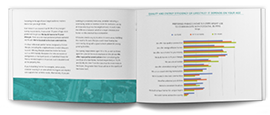Sign up for our LAVY email
and get our bi-monthly newsletter.
The homebuying journey typically starts with search. Today, free traffic from search engines such as Google is harder and harder to come by, especially with all the competition from listing aggregators and local real estate agents. However, if done right, home builders can capture search engine traffic by ranking local community content within their sites.
To begin, you’ll need an existing website for your residential development business. It will become the main hub for local area sections—sometimes referred to as microsites—within the main site as you complete the rest of the steps to expand your digital footprint. These tips assume such a site is already in place, so you can implement the following strategies.
If you want to capture local traffic you need to think like the people who live, or want to live, in the area. What words and phrases do they use when searching for homes located in the communities where you build?
 By local area, we don’t mean your community, because you might have multiple communities within one contiguous geographic area, but the community name people would use in a search. For example, it could be a city name if the city is small enough, but in a larger city, there would be different names for sections of the city. For example, use Queens or Brooklyn versus New York City, or in a sprawling metropolitan area like Phoenix, even within the city of Phoenix you would have defined neighborhoods such as Arcadia, Ahwatukee or Laveen. Think keyword phrase here: new homes in [local area name]. Ideally, you’ll build a set of eight or more related local area pages—each focused on an area which can be tied to a single keyword.
By local area, we don’t mean your community, because you might have multiple communities within one contiguous geographic area, but the community name people would use in a search. For example, it could be a city name if the city is small enough, but in a larger city, there would be different names for sections of the city. For example, use Queens or Brooklyn versus New York City, or in a sprawling metropolitan area like Phoenix, even within the city of Phoenix you would have defined neighborhoods such as Arcadia, Ahwatukee or Laveen. Think keyword phrase here: new homes in [local area name]. Ideally, you’ll build a set of eight or more related local area pages—each focused on an area which can be tied to a single keyword.
Just creating a single local page isn’t enough. What’s needed is an entire site of pages and each page in the set needs to include valuable, substantive, relevant content. Here’s what that means:
For each of these pages you will want to carefully plan the content to include keywords as they would naturally occur in text. No keyword stuffing, please.
To be clear, that doesn’t mean you can’t use your keywords more than once. It simply means to write engaging content meant to be read and understood by people. With advances in technology, especially with speech to text, search algorithms can understand conversational long-tail keyword searches and actually listen for them. Mindless repetition of a specific word or phrase alone, however, won’t get your page noticed—at least not in a good way. The more machines learn to think like humans, the more content writers need to cater to human eyeballs instead of trying to out-maneuver artificial intelligence.
Engaging content is essential, but so is how you present it on the page and in the code. By following a few more technical tips you’ll help search engines identify what is most important allowing them to accurately serve the traffic you most want and need.
Here are a few guidelines:
Structured data: Use structured data, JSON-LD and Schema.org, to provide markup for the location and entities you are including in the content.
Now that you have created your local pages, it’s time to put them to work using link sculpting to integrate them into your main site. These pages shouldn’t necessarily be included in your main site navigation, but you do need a link strategy to integrate them correctly into your site for maximum ranking potential.
Outbound links are good karma. Link out from your content to tightly relevant sources. For example, if you have a page for schools in the area, list and link to each school and maybe even the school district. If you have a page for community organizations, link to related charities. Sponsor youth sports teams in the area and link out to those organizations as well.
If you don’t already have website analytics installed, now is a great time to do so. Gauge current traffic patterns and levels so you have something to compare against once you launch your set of local pages. As new patterns and traffic levels emerge, investigate what’s working and what’s not, and make any adjustments needed. Bear in mind, this isn’t a one-and-done exercise. Keep track of outbound links to make sure you keep them up to date. Seasonal links, especially those for youth sports or other recreational groups or charities which are not active throughout the entire year, might need to be adjusted quarterly.
Not sure where to start? You’re not alone. LAVIDGE can help. That’s why we have a dedicated web team and an analytics team to uncover traffic trends and to help home builders optimize their websites for top results.
To learn more, give us a call at 480.998.2600 or send email to info@lavidge.com.
Carl Chapman, SEO Strategist, contributed to this report.
Wouldn’t it be great if major search engines would get together to agree on best practices when developing for the web? We think so, too. In a way, that has happened to some extent. In 2011, Google, Bing, Yahoo! and Yandex created a unified structure data vocabulary based on the vocabulary used by Schema.org. The result gave birth to JSON-LD, JavaScript Object Notation for Linked Data.
In simpler terms, it is a method of coding to help search engines process nested information in meaningful ways to improve user experience. It is a method of bringing order to the web—and by extension, making the content about your homes more accessible to users.
Think of it this way. When you list a home for sale there are many data points which can and should be listed. You have an address. The number of bedrooms, and the number of bathrooms. Of course, you’ll want to include the price. There might be other upgrades such as covered parking, a garage or a swimming pool. Pulling from each of these data points on its own to get the full picture of whether a buyer might be interested in your home would create quite the challenge for a search engine. When combined into an array (think table) each item can be matched up against like items for accurate parsing against similar listings.
Data Set Example:

In the simplified example above, applying JSON-LD to the data helps search engines easily pull up homes which share the same ZIP Code for easy comparison with other homes in the area. Each item is labeled separately in the code, making it possible for the desired table to appear seamlessly for the viewer.
So far, Google is the only search engine to officially recommend using JSON-LD. Because others tend to follow its lead and because it is the search engine with the most coveted page rankings, we feel safe in recommending JSON-LD to make your websites even more search engine friendly to home buyers with specific wants or needs.
Ready to write some code? Before you get started, you might want to visit the W3 Community Group’s Best Practices released in July 2018. This will be particularly useful if your site interacts with multiple APIs.
JSONschema.net offers a free text editorto help you get started. When you’re ready to test, use Google’s Structured Data Testing Toolto validate your code snippet. You can also use it again to test whether you have applied your JSON-LD markup correctly within either the head or body of your site code.

This article is a brief abstract of our exclusive study about home buyers and their preferences for advertising and marketing tactics used by new home builders.
Sign up for our LAVY email
and get our bi-monthly newsletter.